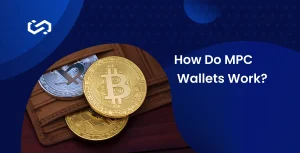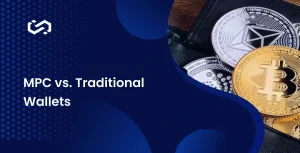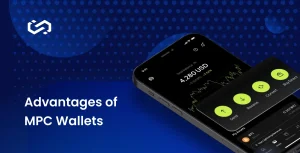What is MPC Wallet?
A Multi-Party Computation wallet distributes a private key across multiple parties so that no single entity ever has access to the full key. When a transaction is signed, each party uses their portion (or “share”) of the key to generate a partial signature. These partials are then combined into one valid signature, without ever reconstructing the full key or exposing individual shares.
This approach removes the single point of failure that plagues traditional wallets. Even if one share is compromised, the attacker cannot access the full key. In practical applications, MPC wallets operate across secure cloud environments and user devices, allowing for flexible and secure signing processes without exposing critical cryptographic material.

Multi-Party Computation Wallet:
As digital asset adoption rises, so does the need for secure and flexible crypto custody solutions. Multi-Party Computation (MPC) wallets have emerged as a next-generation cryptographic tool, addressing the core vulnerabilities of traditional digital asset wallets.
Instead of storing a private key in one place, MPC wallets split it into encrypted shares distributed across multiple parties or devices. This model enhances security, resilience, and institutional readiness.
In cryptocurrency, a wallet is a software or hardware tool that allows users to store, send, and receive digital assets by managing their cryptographic keys. At the core of every wallet is a private key—a critical string of data used to authorize transactions. If this key is lost or stolen, the associated funds can be irretrievably compromised.
Understanding Cryptography
Cryptography is the science of securing communication by transforming readable information into coded formats that can only be understood by authorized parties. At its core, it ensures the confidentiality, integrity, and authenticity of data by using complex mathematical algorithms. Whether it’s safeguarding personal emails or protecting digital assets on a blockchain, cryptography enables messages to be encrypted in a way that makes them unreadable to outsiders.
Only someone with the correct decryption key can access the original content. As digital interactions grow, cryptography plays a crucial role in protecting sensitive data from interception or tampering—making it a foundational technology for modern cybersecurity, blockchain, and secure digital communication.
How do MPC Wallets work?

MPC wallets are based on threshold cryptography and secret sharing principles, like Shamir’s Secret Sharing or more advanced Threshold Signature Schemes (TSS). Here’s how they operate:
1. Key Generation: A distributed key generation (DKG) protocol creates shares of the private key among multiple parties, ensuring that no single party ever sees the full key.
2. Signing: When a transaction needs to be signed, a threshold of participants (e.g., 2-of-3) produce partial signatures using their respective key shares.
3. Combination: These partials are combined mathematically into a complete signature that matches the public key through a cryptographic computation, again, without reconstructing the full private key.
4. Broadcast: Only one final signature is published on-chain, ensuring low fees and high compatibility.
MPC Wallets vs. Traditional Wallets (What are the differences)

To understand the significance of Multi-Party Computation (MPC) wallets, it helps to contrast them with traditional wallet architectures. MPC wallets break away from the conventional model of single-key storage and offer a fundamentally different approach to key management, security, and usability. Here’s how they compare across several categories:
1. Multi-Signature (Multi-Sig) Wallets
Multi-sig wallets require multiple independent private keys, typically held by different parties, to authorize a transaction. Each keyholder signs the transaction individually, and these signatures are recorded on-chain. While this method enhances security, it also introduces performance trade-offs: each signature increases transaction size, fees, and latency.
MPC wallets, in contrast, split a single private key into multiple encrypted shares. The signing process happens collaboratively and entirely off-chain. Partial signatures are combined mathematically into a single valid signature that is indistinguishable from a normal single-key signature. This makes MPC far more cost-efficient and compatible across chains, especially those without native multi-sig support.
2. Hardware Wallets
Hardware wallets store the entire private key in a secure, offline device—typically a USB or hardware token. This setup offers strong protection from online threats, but creates a single point of failure. If the device is lost and the user fails to back up the seed phrase, funds may be irrecoverable.
MPC wallets eliminate this vulnerability by never storing the full key in any one place. Instead, key shares reside across multiple devices or environments—such as a secure enclave in the cloud and a smartphone app. Even if one share is compromised or lost, funds can still be recovered or signed for, as long as the required threshold of shares is maintained.
3. Hot and Cold Wallets
Traditional hot wallets are connected to the internet and are used for quick transactions, but they are more exposed to attack. Cold wallets, kept offline, are more secure but less convenient, often requiring physical access for each transaction.
MPC wallets bridge this divide. Because no full key is ever assembled, key shares can be safely used in online environments without exposing the complete key. Some MPC setups are designed with hybrid signing models—for instance, one share remains in a cold (air-gapped) device while others operate online. This allows users to combine the security benefits of cold storage with the flexibility of a hot wallet.
4. Seed Phrases and Key Recovery
Most traditional wallets depend on a 12- or 24-word seed phrase that represents the full private key. If lost, recovery becomes impossible. If exposed, anyone can access the wallet. This presents both a user experience and a security challenge.
MPC wallets do not rely on a single mnemonic phrase. Key shares can be regenerated or rotated through cryptographic protocols without exposing the full key. For example, if a user replaces a phone or a cloud node, the system can re-establish key shares without requiring the user to input or store a seed phrase. This allows for more secure and seamless backup, recovery, and key rotation.

Advantages of MPC Wallets:
MPC wallets are increasingly favoured by institutions and enterprises for one core reason: they offer a rare combination of strong security, operational flexibility, and usability. While legacy wallets often force users to trade off between safety and convenience, MPC wallets resolve that tension by distributing risk and simplifying key management behind the scenes. Here’s what sets them apart:
1. No Single Point of Failure
Traditional wallets—whether software-based or hardware-based—typically store a complete private key in a single device. This creates a significant vulnerability: if that device is compromised, the attacker gains full control of the assets.
MPC wallets avoid this by never assembling the full private key at any one time or place. Instead, key shares are distributed across multiple trusted parties or systems. A transaction can only be signed when a predetermined threshold (e.g., 2 of 3 or 3 of 5) of those shares is used. This setup dramatically reduces the attack surface, making it much harder for bad actors to steal funds—even in the event of a partial breach.
2. Strong Access Controls and Policy Enforcement
Enterprises need more than just security—they need controls, transparency, and accountability. MPC enables multi-party approval mechanisms (M-of-N schemes) that align perfectly with corporate governance policies. For example, a business can require approvals from both the CFO and the compliance officer for any transfer above a set threshold.
Access policies can be fine-tuned to include role-based permissions, time-locked transactions, or automated triggers for routine payments. These controls are cryptographically enforced, not just policy-based, reducing the risk of human error or insider fraud. In short, MPC makes it possible to build enterprise-grade wallet workflows without requiring complex custom infrastructure.
3. Flexible and Secure Recovery
Key loss is one of the biggest risks in crypto, especially for self-custody solutions. MPC wallets mitigate this by making recovery more flexible and secure. Since no single device holds the full key, the system can tolerate the loss of individual shares—provided the signing threshold can still be met.
For instance, if a company loses access to one device, it can rotate or regenerate that share through cryptographic means without compromising the rest of the system. There’s no need to recover a vulnerable seed phrase or re-issue an entirely new wallet. This improves both business continuity and user confidence.
4. Blockchain-Agnostic Compatibility
Unlike multi-sig wallets, which rely on native support from each blockchain, MPC wallets are blockchain-agnostic. They generate standard cryptographic signatures (typically ECDSA or EdDSA), meaning they work with virtually any chain that supports those algorithms.
That includes Bitcoin, Ethereum, and many other major blockchains. This flexibility allows institutions to use a unified wallet architecture across diverse ecosystems, streamlining both custody operations and technical integration. It also future-proofs the wallet infrastructure—MPC protocols can evolve independently of any single blockchain’s scripting limitations.
Why MPC is the New Standard for Digital Asset Security
To use digital assets, you need both a public key and a private key—the latter being the most critical for security. If your private key falls into the wrong hands, your assets can be stolen instantly. That’s why protecting the private key is fundamental to digital asset security.
Traditionally, private keys have been stored in three main ways:
- Cold Storage (offline)
- Hot Wallets (online)
- Hardware Wallets (physical devices)
1. Cold Storage (offline)
Each method has trade-offs. Cold storage keeps keys offline, reducing exposure to hackers, but is slow—transfers can take up to 48 hours, making it impractical for active trading. It also doesn’t prevent issues like spoofed deposit addresses or stolen credentials.
2. Hardware Wallets (physical devices)
Hardware wallets offer offline storage and are resistant to malware, but they rely on a recovery seed phrase. If that seed is lost, the funds are unrecoverable. They’re also too slow for modern digital asset operations.
3. Hot Wallets (online)
Hot wallets, while faster, are vulnerable to human error (e.g., copying wrong addresses), require constant security measures like 2FA, and often use multisig technology. However, multisig isn’t compatible across all blockchains and lacks flexibility for growing teams.
As digital asset markets evolve, there’s a need for a solution that balances high security with operational efficiency. This is where Multi-Party Computation (MPC) comes in.
MPC eliminates the single point of failure by splitting private key control across multiple parties, allowing for secure storage and fast, seamless transactions—making it the preferred solution for today’s digital asset businesses.
History of MPC Wallet
Multi-Party Computation (MPC) began as a cryptographic concept in the 1980s, designed to let multiple parties compute a result without revealing their inputs. It wasn’t until the rise of digital assets that MPC became practical for securing crypto wallets. Traditional wallets used a single private key; while MPC wallets, emerging in the late 2010s, split the key across multiple parties to remove single points of failure. Today, MPC wallets offer a secure, flexible solution for managing digital assets without ever exposing the full private key.
Institutional Use Cases of MPC wallet
MPC wallets aren’t theoretical—they are already in production across a wide range of institutional settings. Below are the primary scenarios where MPC is actively solving real-world problems in custody, governance, and treasury management.
Custodians and Banks
Major custodial firms and financial institutions, which power institutional clients like Revolut, have adopted MPC to safeguard client assets. These institutions require a balance between military-grade security and real-time operational capability.
By distributing key shares across secure enclaves and requiring multi-party approvals, these organizations can comply with regulatory mandates (such as segregation of duties and KYC/AML controls) while offering clients fast, secure access to their digital assets.
Exchanges and Trading Platforms
Crypto exchanges—especially those operating hot wallets—leverage MPC to prevent internal abuse and external theft without slowing down transactions. By requiring multiple internal approvals (e.g., operations + compliance) before a withdrawal is signed, exchanges reduce single-point vulnerabilities.
Unlike on-chain multi-signature wallets, MPC doesn’t add blockchain overhead, making it ideal for exchanges that must process thousands of withdrawals quickly while maintaining auditability and internal controls.
Corporate Treasury Management
Companies holding crypto as treasury assets can use MPC to enforce proper authorization layers. Instead of giving one executive full control, wallet keys can be distributed among the CFO, CTO, and compliance officer. Payments or transfers can then require at least two approvals, helping reduce fraud and enforce accountability.
MPC also integrates with corporate identity systems, enabling seamless access management as personnel change.
DAOs and DeFi Projects
Decentralized Autonomous Organizations (DAOs) and DeFi platforms use MPC to protect governance or treasury funds. Instead of placing full trust in a single signer or contract admin, DAOs can distribute key shares to core contributors or community members.
Any treasury movement, upgrade, or vote execution can then require a minimum number of approvers, safeguarding the community’s funds against insider threats or accidental actions.
Wallet-as-a-Service (WaaS) Platforms
Wallet service providers—especially those serving enterprises—are increasingly embedding MPC to deliver compliant and secure wallets to their clients. This includes fintechs, neobanks, and asset management platforms offering white-labeled wallets for crypto transactions.
By using MPC under the hood, these platforms can offer best-in-class security (e.g., no single seed phrase, distributed signing) while remaining user-friendly. Built-in compliance features, such as audit logs and access controls, help satisfy the needs of regulated users.
MPC Wallets Are the Future of Secure Institutional Crypto
As institutional adoption of digital assets accelerates, so do expectations around security, governance, and compliance. MPC wallets offer a practical path forward—combining enterprise-grade protection with the operational agility needed in modern markets. By eliminating single points of failure, supporting flexible access policies, and integrating seamlessly across blockchains, MPC has become the standard for serious custodians, exchanges, and crypto-native institutions.
But implementing MPC securely requires the right infrastructure partner. ChainUp offers white label MPC wallet tailored for institutional needs. From secure key management and policy controls to audit-ready reporting, ChainUp provides you with the compliance and flexibility to scale your digital asset operations with confidence.
Contact the ChainUp team to learn how we can help your institution deploy secure, compliant white label MPC wallets today.




